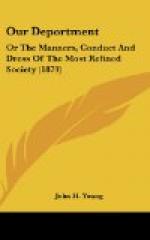The pall-bearers, usually six, but sometimes eight, when the deceased is a person of considerable prominence, are generally chosen from the intimate acquaintances of the deceased, and of nearly the same age. If they walk to the cemetery, they take their position in equal numbers on either side of the hearse. If they ride, their carriage or carriages precede the hearse.
ORDER OF THE PROCESSION.
The carriages containing the clergyman and pall-bearers precede the hearse, immediately following which are the carriages of the nearest relatives, more distant relatives and friends respectively. When societies or masonic bodies take part in the procession they precede the hearse.
The horse of a deceased mounted military officer, fully equipped and draped in mourning, will be led immediately after the hearse. As the mourners pass out to enter the carriage, the guests stand with uncovered heads. No salutations are given or received. The person who officiates as master of ceremonies, assists the mourners to enter and alight from the carriages. At the cemetery the clergyman or priest walks in advance of the coffin. In towns and villages where the cemetery is near at hand and the procession goes on foot, the men should go with uncovered heads, if the weather permit, the hat being held in the right hand. Guests return to their respective homes after the services at the grave.
FLORAL DECORATIONS.
The usual decorations of the coffin are flowers, tastefully arranged in a beautiful wreath for a child or young person, and a cross for a married person, which are placed upon the coffin. These flowers should mostly be white. Near friends of the deceased may send beautiful floral devices, if they wish, as a mark of their esteem for the deceased, which should be sent in time to be used for decorative purposes.
OTHER DECORATIONS.
A person of rank generally bears some insignia upon his coffin. Thus a deceased army or naval officer will have his coffin covered with the national flag, and his hat, epaulettes, sword and sash laid upon the lid. The regalia of a deceased officer of the Masonic or Odd Fellows’ fraternity is often placed upon the coffin.
CALLS UPON THE BEREAVED FAMILY.
About a week after the funeral, friends call upon the bereaved family, and acquaintances call within a month. The calls of the latter are not repeated until cards of acknowledgment have been received by the family, the leaving of which announces that they are ready to see their friends. It is the custom for friends to wear no bright colors when making their calls of condolence. In making first calls of condolence, none but most intimate friends ask to see the family. Short notes of condolence, expressing the deepest sympathy, are usually accepted, and help to comfort stricken hearts. Formal notes of condolence are no longer sent. Those who have known anything of the unsounded depths of sorrow do not attempt consolation. All that they attempt to do is to find words wherein to express their deep sympathy with the grief-stricken ones.




